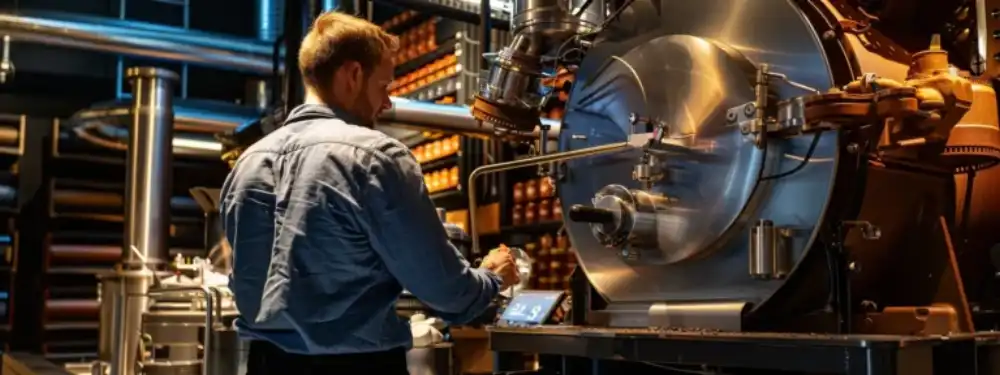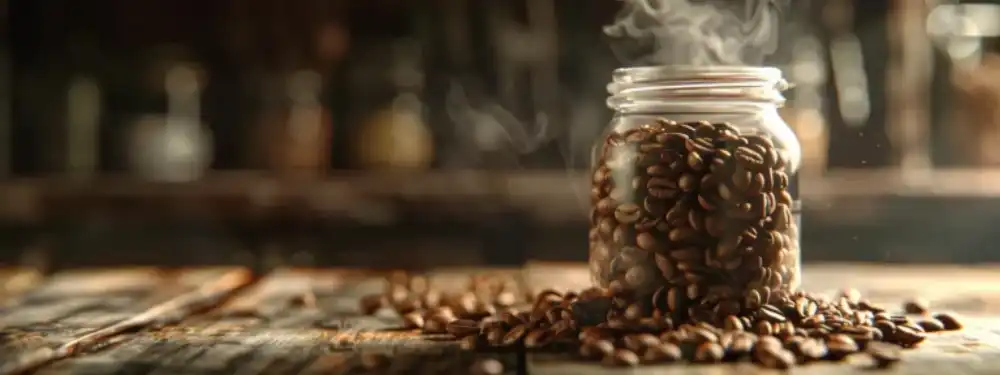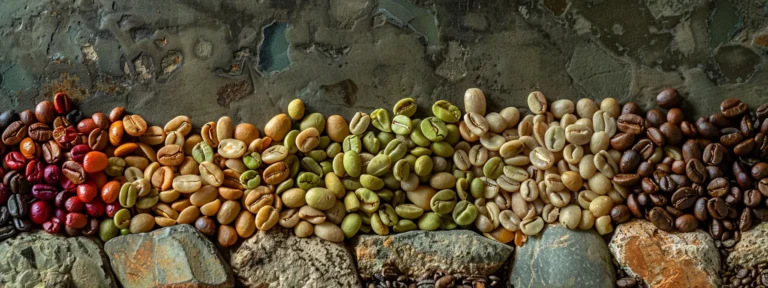Table Of Contents:
- From Green to Gourmet: Home Espresso Bean Roasting
- Key Takeaways
- Choosing the Best Green Beans for Espresso
- Identifying Your Flavor Profile Preferences
- Selecting Beans Based on Origin and Variety
- The Essentials of Home Roasting Equipment
- Overview of Roasting Machines and Alternatives
- Setting Up Your Roasting Station at Home
- Mastering the Roasting Process Step by Step
- Understanding the Stages of Bean Development
- Adjusting Time and Temperature for Perfect Roast Profiles
- Cooling and Storing Your Freshly Roasted Beans
- Efficient Methods to Cool Down Beans Post-Roast
- Tips for Airtight Storage to Preserve Freshness
- Grinding Techniques for Optimal Espresso Extraction
- Conclusion
From Green to Gourmet: Home Espresso Bean Roasting
Home espresso bean roasting has gained popularity among coffee enthusiasts, offering a unique opportunity to create custom blends and explore the best espresso brands. Coffee roasters can now purchase green beans at an affordable sale price, allowing them to experiment with various origins and flavor profiles. The roasting process transforms these raw beans, reducing their acidity and developing complex flavors reminiscent of popular roasters like Onyx. In this article, we’ll guide you through the journey of home espresso roasting, from selecting the finest green beans to mastering the art of roasting and grinding for optimal extraction.
Key Takeaways
- Selecting the right green beans is crucial for crafting exceptional espresso at home
- Origin and variety of coffee beans significantly influence the final espresso taste
- Proper equipment and setup are essential for transforming green beans into gourmet espresso
- Understanding roasting stages and adjusting time and temperature create perfect roast profiles
- Rapid cooling and proper storage preserve the complex flavors developed during roasting
Choosing the Best Green Beans for Espresso
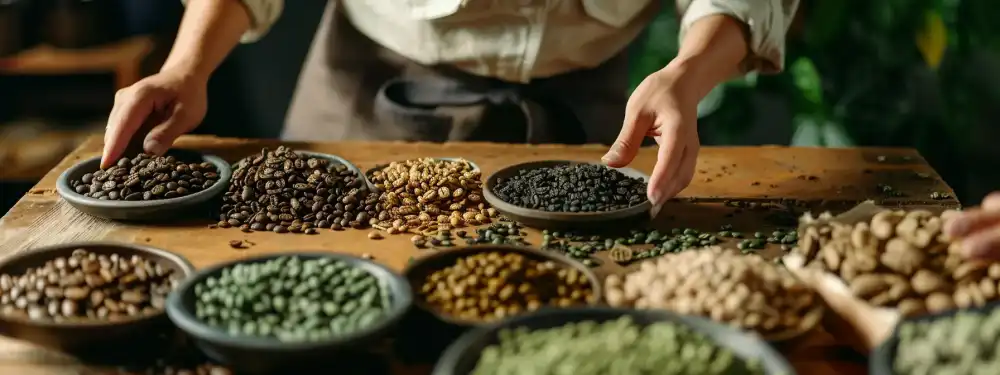
I’ve learned that selecting the right green beans is crucial for crafting exceptional espresso at home. As I explore the world of coffee culture, I’ve discovered that factors like flavor profile preferences and bean origin play pivotal roles. Whether you’re searching for the best espresso beans on Amazon or seeking good coffee beans for espresso from renowned regions like Colombia, understanding these elements is key. Even if you’re a fan of unique offerings like the best chocolate covered coffee beans, the principles of selection remain the same. Let’s delve into how to identify your flavor preferences and choose beans based on their origin and variety to elevate your home roasting game.
Identifying Your Flavor Profile Preferences
I’ve discovered that pinpointing my flavor preferences is key to selecting the perfect green beans for my espresso machine. My journey led me to explore a range of options, from the bright, fruity notes of Costa Rica beans to the rich, chocolatey profiles of organic espresso beans. For those seeking a caffeine-free option, I found that the best decaf espresso beans or best decaf beans for espresso can still offer complex flavors that rival their caffeinated counterparts.
Selecting Beans Based on Origin and Variety
I’ve discovered that the origin and variety of coffee beans significantly influence the final espresso taste. When selecting green beans, I consider renowned coffee-growing regions like Colombia, Ethiopia, and Brazil, each offering unique flavor profiles. I’ve found that some of the best coffee beans for espresso come from blends, combining beans from different origins to create complex flavors. For those who enjoy flavored coffee, I’ve experimented with hazelnut-infused beans, though I prefer to start with high-quality, unflavored green beans and add flavoring during the roasting process. My goal is always to achieve fresh roasted espresso beans that showcase the best characteristics of their origin and variety:
Mastering the art of selecting green beans for espresso sets the stage for an exhilarating journey into home roasting. Now, let’s dive into the essential equipment that will transform those carefully chosen beans into a sensational brew.
The Essentials of Home Roasting Equipment
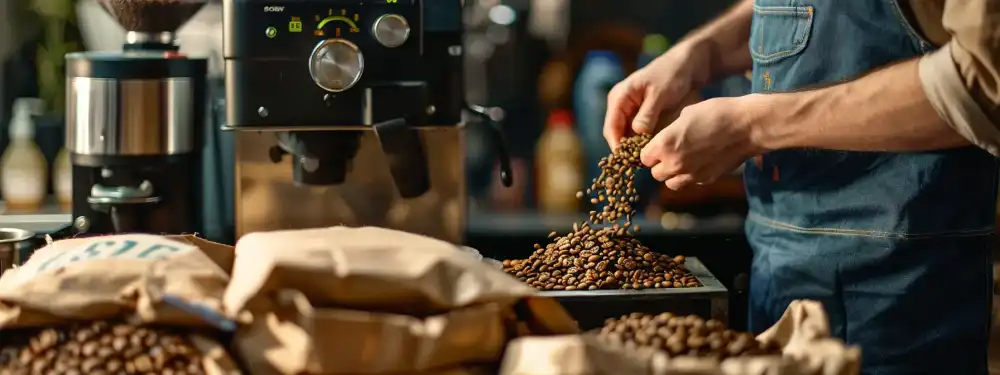
I’ve found that the right equipment is crucial for transforming green beans into gourmet espresso at home. Whether you’re working with Ethiopian Yirgacheffe or Jamaica Blue Mountain, having the proper tools can make all the difference. I’ve experimented with various setups, from dedicated roasting machines to creative alternatives like repurposed popcorn poppers. My journey has led me to appreciate the nuances of different beans, including the fruity notes of a mango-processed whole bean coffee or the rich complexity of a Black Cat espresso blend. In this section, I’ll share my insights on selecting the best roasting equipment and creating an efficient home roasting station.
Overview of Roasting Machines and Alternatives
I’ve explored various roasting machines and alternatives for my home coffee roasting setup. Heat management is crucial, whether I’m using a dedicated roaster or a repurposed popcorn popper, to achieve the perfect balance of flavors like chocolate and berry notes in my quest for the best whole bean espresso. My home roasting coffee journey has taught me that even simple methods can produce exceptional results, rivaling those of commercial roasters.
Setting Up Your Roasting Station at Home
I’ve found that setting up an efficient home roasting station is crucial for achieving consistent, high-quality results. My setup includes a dedicated space with proper ventilation, heat-resistant surfaces, and easy access to power outlets. I keep my green beans in airtight containers in a cool, dry place – not the refrigerator – to maintain their freshness and flavor potential. Sustainability is a key consideration in my roasting process, so I’ve invested in energy-efficient equipment and source my beans from ethical suppliers. While the initial cost may seem high, I’ve calculated that the unit price per cup is significantly lower than buying pre-roasted beans, allowing me to enjoy premium espresso with rich caramel notes and smooth cream-like textures without breaking the bank.
You’ve got the gear, now let’s fire it up! Dive into the heart of coffee roasting as we unlock the secrets of transforming raw beans into aromatic perfection.
Mastering the Roasting Process Step by Step
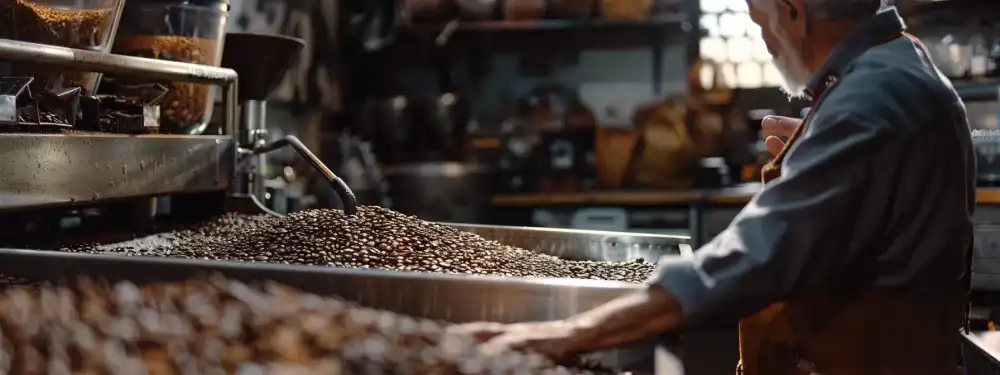
I’ve found that mastering the roasting process is crucial for creating the best coffee beans for espresso machines. As I delve deeper into specialty coffee, I’ve learned to appreciate the nuanced stages of bean development and how adjusting time and temperature can create perfect roast profiles. Whether I’m working with nutty Brazilian beans or a complex blend from Stumptown coffee roasters, understanding these principles allows me to tailor my roasts to my preference. In this section, I’ll share my insights on the key stages of roasting and how to fine-tune your process for exceptional results.
Understanding the Stages of Bean Development
I’ve learned that understanding the stages of bean development is crucial for producing the best espresso beans at home. As I roast my fresh Kenya beans in my modified popcorn maker, I closely monitor the transformation from green plant material to aromatic brown seeds. I’ve discovered that each stage, from drying to first crack and beyond, plays a vital role in developing the complex flavors I crave in my espresso.
Adjusting Time and Temperature for Perfect Roast Profiles
I’ve found that adjusting time and temperature is crucial for achieving perfect roast profiles in coffee roasting. While experimenting with different beans, I’ve discovered that subtle changes in heat application can dramatically alter the flavor profile, much like how steeping time affects tea. I carefully monitor the temperature throughout the process, using water-cooled probes for accuracy, and adjust the heat to coax out desired flavors like vanilla or to prevent unwanted bitterness that can occur in drip coffee made from over-roasted beans.
The journey doesn’t end when the beans turn golden brown. Now, let’s dive into the crucial steps that preserve your coffee’s freshly roasted magic.
Cooling and Storing Your Freshly Roasted Beans
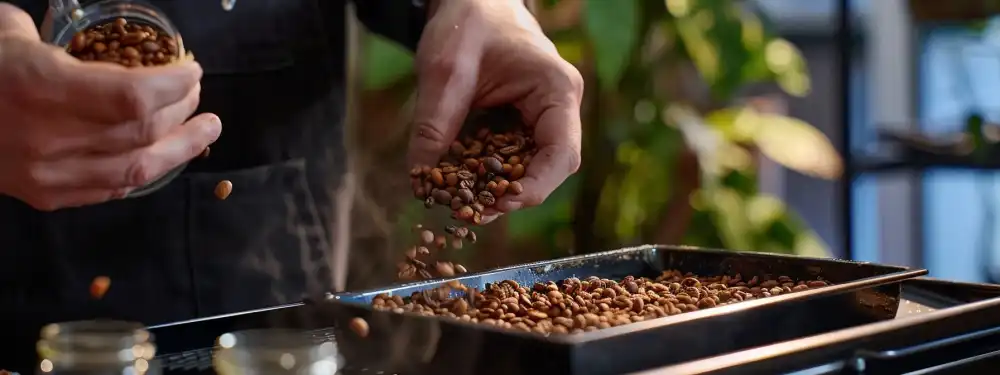
I’ve discovered that cooling and storing freshly roasted beans are crucial steps in preserving their flavor and aroma. Just as the right ratio of spices can enhance a dish, proper cooling and storage techniques can elevate my espresso experience. I’ve experimented with various methods, from using a colander to a dedicated cooling tray, to rapidly bring down the temperature of my beans post-roast. This process is essential in halting the roasting process and locking in the desired flavor profile, whether I’m aiming for notes of orange or a hint of marzipan. Once cooled, I focus on storing my beans in airtight containers to maintain their freshness, much like preserving different species of coffee plants. In this section, I’ll share my insights on efficient cooling methods and storage tips to ensure that every cup of espresso I brew captures the full spectrum of flavors I’ve worked hard to develop during the roasting process.
Efficient Methods to Cool Down Beans Post-Roast
I’ve found that rapid cooling is crucial for preserving the complex flavors I’ve developed during roasting, especially when aiming for good espresso beans. My preferred method involves using a large colander and gently shaking the beans to release heat quickly, much like how removing the cherry from the coffee seed affects its flavor profile. For larger batches of whole bean espresso, I use a cooling tray with a fan underneath, which creates negative pressure to draw hot air away from the beans efficiently.
Tips for Airtight Storage to Preserve Freshness
I’ve found that proper storage is crucial for preserving the best espresso beans and maintaining their quality for superautomatic espresso machines. I store my freshly roasted beans in airtight containers with one-way valves, which allow CO2 to escape without letting oxygen in, ensuring the best whole bean coffee for espresso stays fresh longer. For larger quantities, I use vacuum-sealed bags to protect against moisture and air exposure, extending the shelf life of my carefully roasted espressos.
Fresh beans await their final transformation. Let’s dive into the world of grinding, where precision unlocks espresso perfection.
Grinding Techniques for Optimal Espresso Extraction
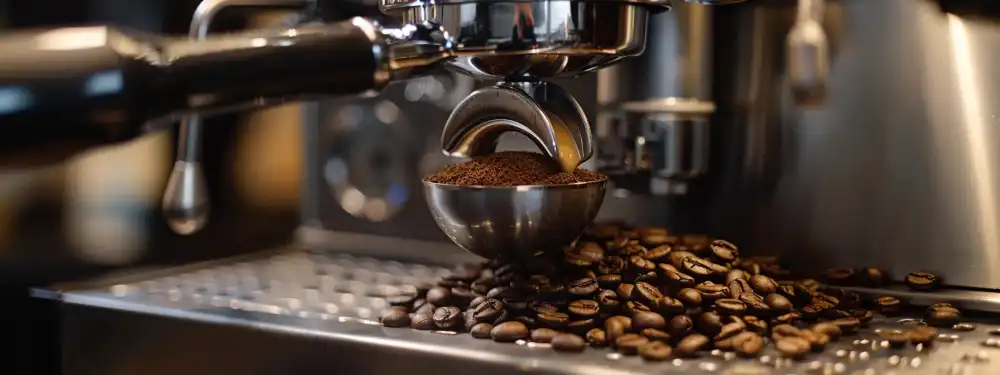
I’ve discovered that grinding techniques play a crucial role in achieving optimal espresso extraction. As I experiment with various fair trade beans, including the coveted Jamaican Blue Mountain coffee, I’ve learned that the grind size significantly impacts the taste of my home-roasted espresso. My goal is to replicate the rich, complex flavors found in the best Italian espresso beans.
Through trial and error, I’ve found that different roast levels require specific grind settings. For lighter roasts, I tend to use a finer grind to extract the delicate flavors, while darker roasts often benefit from a slightly coarser grind. This attention to detail has helped me create espresso that rivals even the renowned Intelligentsia blends:
I’ve learned that consistency in grind size is key to achieving balanced extractions. I invest in a quality burr grinder and regularly calibrate it to ensure uniform particle size. This precision allows me to fine-tune my espresso shots, bringing out the best flavors from my home-roasted beans, whether I’m working with a single-origin or a carefully crafted blend.
Conclusion
Home espresso bean roasting transforms green beans into gourmet coffee, offering unparalleled freshness and flavor control. Selecting high-quality green beans, mastering roasting techniques, and proper storage are essential steps in crafting exceptional espresso. Precision in grinding and extraction further enhances the home roaster’s ability to create cafe-quality espresso. This hands-on approach not only saves money but also allows coffee enthusiasts to explore a wide range of flavors and develop a deeper appreciation for the art of espresso making.





